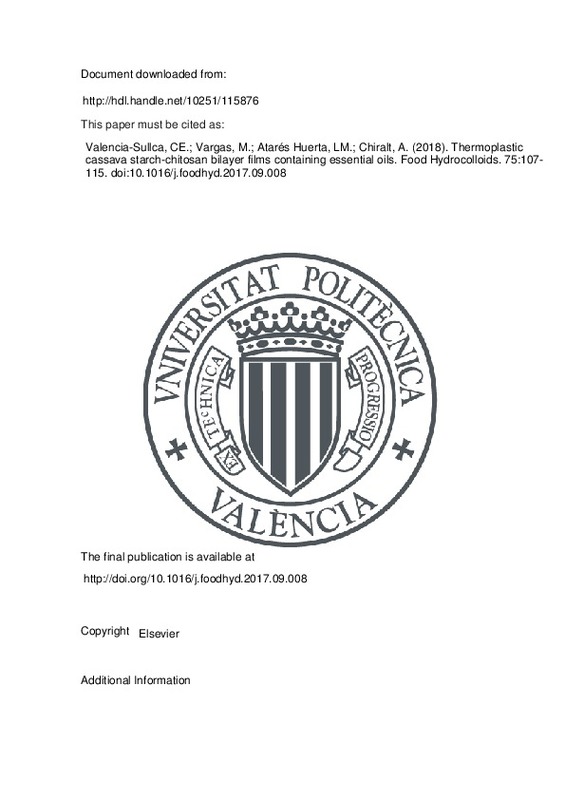JavaScript is disabled for your browser. Some features of this site may not work without it.
Buscar en RiuNet
Listar
Mi cuenta
Estadísticas
Ayuda RiuNet
Admin. UPV
Thermoplastic cassava starch-chitosan bilayer films containing essential oils
Mostrar el registro sencillo del ítem
Ficheros en el ítem
| dc.contributor.author | Valencia-Sullca, Cristina Encarnación
|
es_ES |
| dc.contributor.author | Vargas, Maria
|
es_ES |
| dc.contributor.author | Atarés Huerta, Lorena María
|
es_ES |
| dc.contributor.author | Chiralt, A.
|
es_ES |
| dc.date.accessioned | 2019-01-20T21:04:13Z | |
| dc.date.available | 2019-01-20T21:04:13Z | |
| dc.date.issued | 2018 | es_ES |
| dc.identifier.issn | 0268-005X | es_ES |
| dc.identifier.uri | http://hdl.handle.net/10251/115876 | |
| dc.description.abstract | [EN] Starch-chitosan bilayer films, containing or not essential oils in the casted chitosan layer were obtained by thermo-compression. Bilayer films exhibited a good interfacial adhesion and better mechanical resistance than starch monolayers, although they were less stretchable and less transparent. Starchchitosan films were effective at controlling the bacterial growth in pork meat, but the thermal treatment applied to obtain the bilayers reduced their antimicrobial properties as compared to chitosan monolayers. The addition of essential oils did not promote any antimicrobial action in chitosan mono and bilayer films applied to pork meat. The final amount of essential oils in the films was very limited probably due to the losses occurred during film processing method. Other strategies to incorporate the essential oils into chitosan-based films should be used to improve their final retention in the film matrix and their effective release into the coated food. (C) 2017 Elsevier Ltd. All rights reserved. | es_ES |
| dc.description.sponsorship | The authors acknowledge the financial support provided by the Spanish Ministerio de Economia y Competividad (Projects AGL2013-42989-R and AGL2016-76699-R). Author Cristina Valencia-Sullca thanks the Peruvian Grant National Program (PRONABEC). | es_ES |
| dc.language | Inglés | es_ES |
| dc.publisher | Elsevier | es_ES |
| dc.relation.ispartof | Food Hydrocolloids | es_ES |
| dc.rights | Reconocimiento - No comercial - Sin obra derivada (by-nc-nd) | es_ES |
| dc.subject | Polysaccharide | es_ES |
| dc.subject | Thermal degradation | es_ES |
| dc.subject | Tensile properties | es_ES |
| dc.subject | Antimicrobial | es_ES |
| dc.subject.classification | TECNOLOGIA DE ALIMENTOS | es_ES |
| dc.title | Thermoplastic cassava starch-chitosan bilayer films containing essential oils | es_ES |
| dc.type | Artículo | es_ES |
| dc.identifier.doi | 10.1016/j.foodhyd.2017.09.008 | es_ES |
| dc.relation.projectID | info:eu-repo/grantAgreement/MINECO//AGL2016-76699-R/ES/Materiales Biodegradables Multicapa de Alta Barrera para el Envasado Activo de Alimentos/ | es_ES |
| dc.relation.projectID | info:eu-repo/grantAgreement/MINECO//AGL2013-42989-R/ES/NUEVOS MATERIALES BIODEGRADABLES MULTICAPA PARA ENVASADO ACTIVO DE ALIMENTOS SENSIBLES AL DETERIORO MICROBIANO Y%2FO OXIDATIVO/ | es_ES |
| dc.rights.accessRights | Abierto | es_ES |
| dc.date.embargoEndDate | 2019-02-01 | es_ES |
| dc.contributor.affiliation | Universitat Politècnica de València. Departamento de Tecnología de Alimentos - Departament de Tecnologia d'Aliments | es_ES |
| dc.description.bibliographicCitation | Valencia-Sullca, CE.; Vargas, M.; Atarés Huerta, LM.; Chiralt, A. (2018). Thermoplastic cassava starch-chitosan bilayer films containing essential oils. Food Hydrocolloids. 75:107-115. https://doi.org/10.1016/j.foodhyd.2017.09.008 | es_ES |
| dc.description.accrualMethod | S | es_ES |
| dc.relation.publisherversion | http://doi.org/10.1016/j.foodhyd.2017.09.008 | es_ES |
| dc.description.upvformatpinicio | 107 | es_ES |
| dc.description.upvformatpfin | 115 | es_ES |
| dc.type.version | info:eu-repo/semantics/publishedVersion | es_ES |
| dc.description.volume | 75 | es_ES |
| dc.relation.pasarela | S\352333 | es_ES |
| dc.contributor.funder | Ministerio de Educación, Perú | |
| dc.contributor.funder | Ministerio de Economía y Competitividad | es_ES |







![[Cerrado]](/themes/UPV/images/candado.png)

